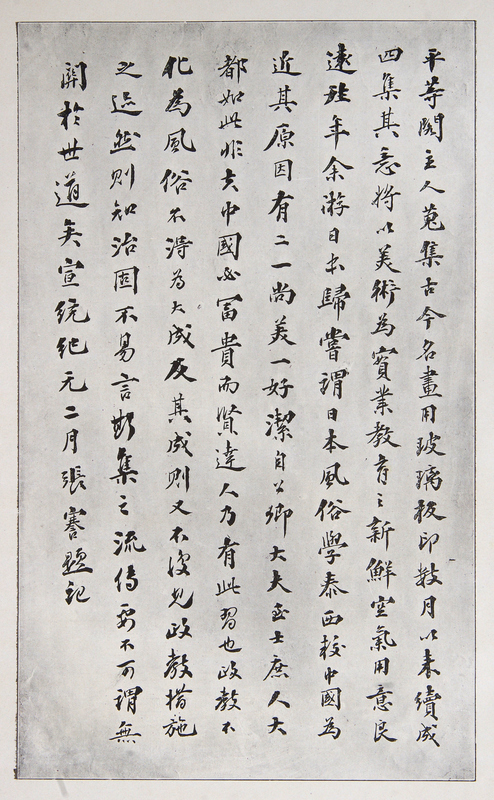 |
04_15
Zhang Jian : preface
|
|
平等閣主人蒐集古今名畫,用玻璃板印,數月以來,續成
四集。其意將以美術為實業、教育之新鮮空氣,用意良
遠。往年,餘遊日本歸,嘗謂日本風俗學泰西較中國為
近,其原因有二:一尚美,二好潔。自公卿大夫至士庶人大
都如此,非夫中國必富貴而賢達乃有此習也。政教不
化為風俗,不得為大成,及其成,則又不復見政教措施
之跡,然則知治固不易言。斯集之流傳,要不可謂無
關於世道矣。
|
|
The Master of the Equality Pavilion [i.e. Di Baoxian]
has broadly accumulated famous paintings, ancient and modern. Using
glass plate printing, for the last several months he has continued to
produce four series [of reproductions]. His intent is to use the fine
arts as a fresh atmosphere for practical arts/industrial education.
It is of profound significance.
Last year when I was sojourning
in Japan and hadn’t yet returned, I said: Japanese customs study the
Occident, and compared with China, they are closer [to the Occident],
more modernized. There are two reasons for this: the first is
their esteem of beauty ; the second is their love of cleanliness
. From high officials to ordinary people all are like this.
It’s
not that departing from the Chinese model will inevitably result in
riches and achievement, but that their people possess these habits. If
this kind of political acculturation is not transformed into custom, we
can’t obtain this kind of great achievement. If we reach this achievement,
then the traces of the ways and means of this political acculturation
are nowhere to be found.
However the knowledge of how to rule is not easy to articulate. This
effort to compile and disseminate [paintings] cannot
be said to be unrelated to the course of contemporary events.
Source : Richard Vinograd, Art Publishing, Cultural Politics, and Canon Construction in the Career of Di Baoxian, in Joshua A. Fogel (ed.), The role of Japan in modern Chinese art, escholarship, 2013, p.252
|
|